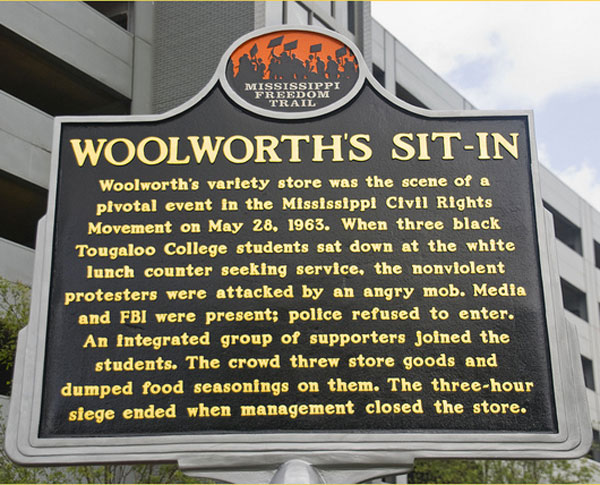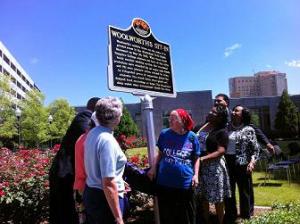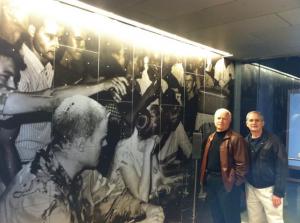

The Civil Rights sit-in a the Woolworth changed Mississippi. Woolworth's has been gone for decades, and the marker stands in a grassy area between a parking garage and a high-rise office building, about two blocks west of the Governor's Mansion. Photo Credit: themississippilink.com
By Emily Wagster Pettus - Associated Press.
The Civil Rights sit-in at Woolworth's five-and-dime store in Jackson, Mississippi changed the state forever. While the store is no longer there, a hitorical marker was recently unvailed where it once stood.
May 28, 1963, started as just another work day for Jackson Daily News photographer Fred Blackwell. Within hours, he captured black-and-white images that traveled around the world and brought attention to the hostility that civil rights activists were facing in Mississippi's capital city.
Now, Blackwell's most famous photo from that day is part of a historical marker commemorating the sit-in at the Woolworth's five-and-dime store in downtown Jackson. A racially mixed group sat at the whites-only lunch counter to challenge segregation. For about three hours, until the manager closed the store for the day, the group was attacked by a violent white mob, including dozens of students from nearby Central High School.
Blackwell's photo that's on the back of the marker shows three of the sit-in participants - Tougaloo College sociology professor John Salter and two Tougaloo students, Joan Trumpauer and Anne Moody - covered in mustard, ketchup and sugar as an all-white crowd jeers. One young man pours sugar over Trumpauer's neatly coiffed hair. Another takes a drag on a cigarette.
Blackwell, 22 at the time, stood atop the lunch counter to take pictures because that gave him a good angle on the action.
"I got permission from the management because they said, 'We're closing this counter today, anyway. It will never be open again,'" Blackwell recalled this past week after the historical marker was unveiled. "There were no other still photographers in there. I kind of had free rein of the place. I just never moved. It was a great place to be."
Did he know his photos would be memorable?
"I knew, yeah, because it was mean pictures," Blackwell said. "Those are the bravest people I've ever seen in my life. What they went through … pictures don't tell the story."

Blackwell's most famous photo from that day is part of a historical marker commemorating the sit-in at the Woolworth's five-and-dime store in downtown Jackson. A racially mixed group sat at the whites-only lunch counter to challenge segregation. Photo Credit: facebook.com
More than 150 people attended the unveiling of the historical marker, which took place on the 50th anniversary of the sit-in. It is the 12th entry on the Mississippi Freedom Trail, a series of signs the state started putting up in 2011 to commemorate people and events that challenged Jim Crow.
The Woolworth's has been gone for decades, and the marker stands in a grassy area between a parking garage and a high-rise office building, about two blocks west of the Governor's Mansion.
Longtime Mississippi reporter Bill Minor of Jackson, who was 41 at the time, covered the sit-in for The Times-Picayune. He said the crowd was incredibly loud, yet the sit-in participants kept their composure.
"It tears your heart out to watch this going on," Minor said. "You have to draw the line and not participate. You can't become involved."
Bob Bullock, who also still lives in the Jackson area, was a 25-year-old television cameraman for Jackson's WJTV-Channel 12 on that day in 1963.
"I was knocked to the floor by someone that didn't want to have their picture made," Bullock recalled. "You had a crowd around you, there were a lot of things being said, they were jeering, there was comments being made. And you're standing in the middle of it."
A book published this year, "We Shall Not Be Moved: The Jackson Woolworth's Sit-In and the Movement It Inspired," provides a detailed account of the sit-in, the events leading up to it and events that followed. Author M.J. O'Brien of Fairfax, Va., spent years researching and writing it.
Blackwell, the Daily News photographer, said the sit-in participants were "amazing people for doing what they did."
"All the glory goes to those people and their nerve," Blackwell said. "It's just a better world today because of it. Don't you
Copyright 2013 The Associated Press.
Featured Photo Credit: Ron Cogswell
Article reprinted with permission of USAonRace.com








No Responses to “Civil Rights Sit-In At Woolworth Changed Mississippi”